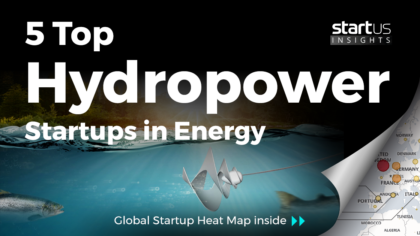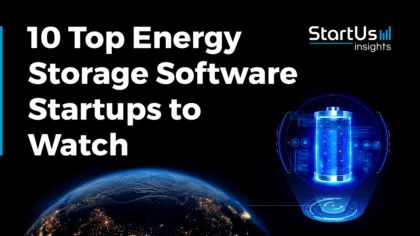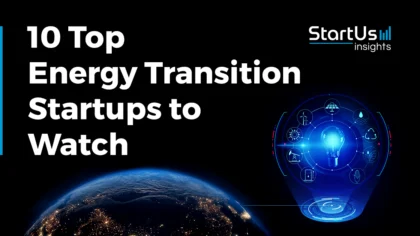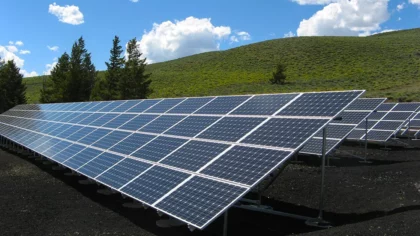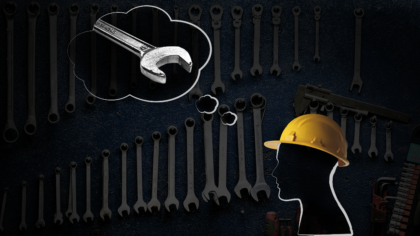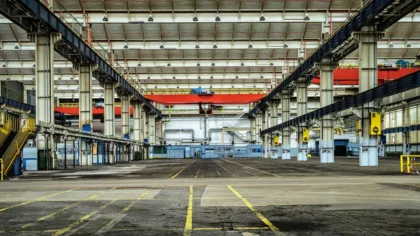Accelerate Productivity in 2025
Reignite Growth Despite the Global Slowdown
Our Innovation Analysts recently looked into emerging technologies and up-and-coming startups working on solutions for the energy sector. As there is a large number of startups working on a wide variety of solutions, we want to share our insights with you. This time, we are taking a look at 5 promising hydropower startups.
Heat Map: 5 Top Hydropower Startups
For our 5 top picks, we used a data-driven startup scouting approach to identify the most relevant solutions globally. The Global Startup Heat Map below highlights 5 interesting examples out of 105 relevant solutions. Depending on your specific needs, your top picks might look entirely different.
Hace – Wave-Capture Power Generation
Sources of clean energy such as wind and solar often lose productivity due to seasonal changes in climate. Power generators that capture the energy from waves are a good alternative to tackle the challenges faced by other renewable sources. The technology allows for the diversification of energy sources, reducing emissions along with dependency on expensive fuel imports. The benefits of wave energy are felt best during the winter seasons. This includes an increase in power generation and a significant total potential. Potential early adopters of this clean wave energy are regions with a long sea border and island nations that spend a lot of money on fuel imports.
French startup Hace develops wave technology that incorporates a modular design to be adapted for various types of marine deposits, such as a coastal strip or offshore marine deposits. Their patented process takes advantage of the immense reserve of wave energy to produce electricity. Hace’s wave motors integrate with offshore wind turbines, making it possible to increase the amount of electricity generated. Integrated energy stations also remove the obstacle of intermittent energy availability and make installing this infrastructure less expensive.
Big Moon – Coastal Hydropower Plants
Setting up tidal stations requires almost no changes to the coastal landscape and eventually prevents harmful emissions from escaping into the atmosphere. Such power plants accurately predict the generation of electric energy, as the ebbs and flows of waves are a well-studied phenomenon. Other benefits of hydropower plants include improved energy efficiency due to the high utilization of installed capacity, as well as the low cost of generated electric energy.
The US-based startup Big Moon develops a technology to harness tidal energy without installing anything on the ocean floor or creating a negative impact on the environment. Their installations are easy to maintain and suitable for commercial use, resulting in affordable, clean, safe, and perpetually generated energy.
Turbulent – Whirlpool Turbines
Generating sustainable hydropower is a major challenge today as energy stations are installed far away from human populations. In order to provide electricity to small settlements, farms, and individual houses, whirlpool turbines are installed in small rivers or check dams. A whirlpool turbine uses small rapids or waterfalls to generate energy. Unlike large dams, this low-pressure turbine requires a height difference of approximately five feet for efficient operation, making clean energy more accessible to different remote or poor regions.
Belgian startup Turbulent creates resilient and cost-efficient turbines for employing in rivers and requiring a low height fall. They intend to provide environmentally-friendly hydropower for remote communities. Turbulent’s whirlpool system is fish-friendly as it diverts the incoming flow into a low-pressure vortex, allowing aquatic life to pass through unharmed. Other benefits of their turbines include ease of installment and maintenance, a longer operating life, and remote control and monitoring.
BladeRunner Energy – Small-Scale Hydropower
Large hydroelectric power stations struggle with expensive transmission costs and problems associated with their negative impact on the environment. Small-scale hydropower plants help solve these challenges and also facilitate a decentralized energy supply. Small-scale hydropower is capable of providing energy to hard-to-reach and isolated regions, as well as see faster returns on investment, due to the low capital costs involved during the construction of these plants.
Dutch startup BladeRunner Energy offers a scalable micro-hydro solution driven by the global need for energy equality, sustainable power generation, and accountability for environmental impact. Their technology harnesses the energy from the natural flow of water without needing to build a dam. They employ their proprietary rotor, that incorporates a design inspired by the natural motion of water, to improve energy efficiency. The flexible power takeoff configuration allows for the generator and power electronics to be housed above the water, dramatically reducing costs while improving reliability.
Naval Energies – Ocean Thermal Energy Conversion (OTEC)
One of the biggest challenges in the adoption of solar power is its intermittent and unstable supply that requires a base-load power supply from another source. Ocean thermal energy conversion technology allows for the efficient utilization of solar energy by harnessing the energy from the oceans that absorb a massive amount of solar radiation. The difference in temperature between the warmer surface and the colder deep runs a heat engine that converts thermal energy into electricity.
French startup Naval Energies designs and develops thermal exchangers used in OTEC technologies that exploit this temperature difference between cold and warm ocean water to produce electricity. Such predictable and continuously repetitive systems generate energy in a closed-loop throughout the year. In addition, these energy systems are environmentally-friendly and reduce carbon emissions. They facilitate in end-to-end construction of onshore OTEC systems.
What About The Other 100 Solutions?
While we believe data is key to creating insights it can be easy to be overwhelmed by it. Our ambition is to create a comprehensive overview and provide actionable innovation intelligence for your Proof of Concept (PoC), partnership, or investment targets. The 5 hydropower startups showcased above are promising examples out of 105 we analyzed for this article. To identify the most relevant solutions based on your specific criteria and collaboration strategy, get in touch.
